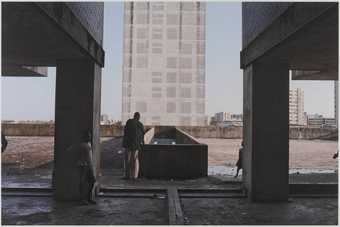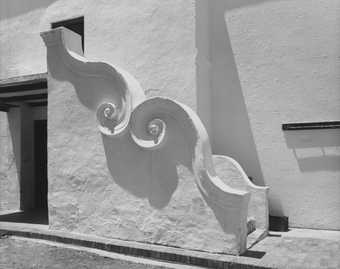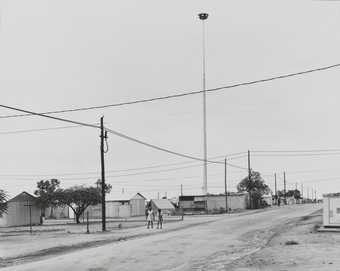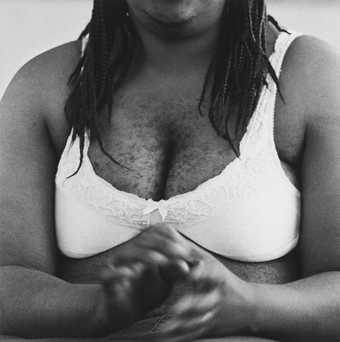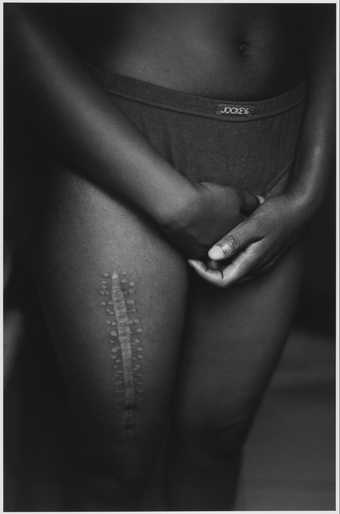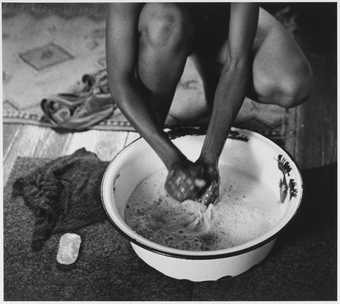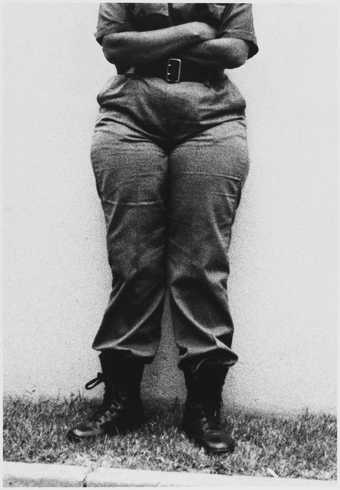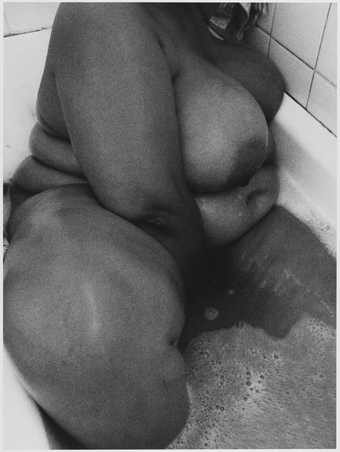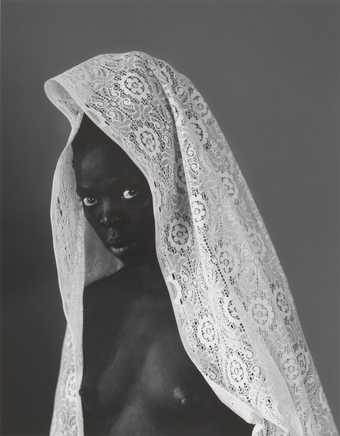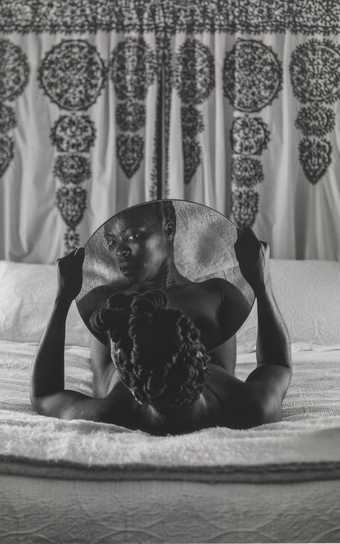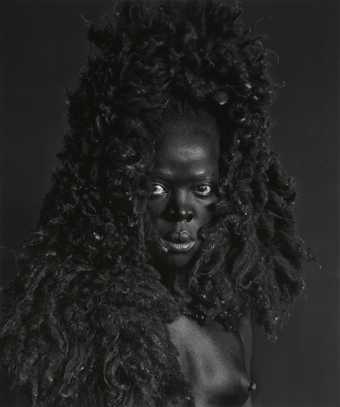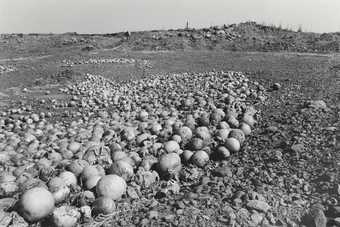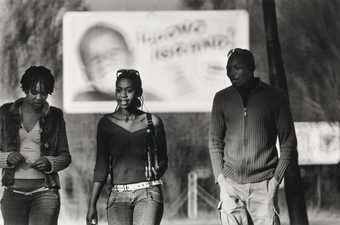
In Tate Britain
Prints and Drawings Room
View by appointment- Artist
- Zanele Muholi born 1972
- Medium
- Photograph, gelatin silver print on paper
- Dimensions
- Image: 353 × 480 mm
support, secondary: 454 × 580 mm - Collection
- Tate
- Acquisition
- Purchased with funds provided by Wendy Fisher 2015
- Reference
- P81289
Summary
This is one of a group of six gelatin silver prints in Tate’s collection from Zanele Muholi’s series Only Half the Picture 2003–6 (Tate P81289–P81294). The series, which exists in an edition of eight with one artist’s proof, dates from an early moment in Muholi’s career; it was foundational for much of their later practice which confronts stereotypes and taboos faced by the black LGBTQI+ community in South Africa. Muholi trained at the Market Photo Workshop in Johannesburg, an organisation founded in 1989 by South African photographer David Goldblatt (1930–2018) to ensure that visual literacy was accessible to all. Muholi’s first-hand knowledge of the LGBTQI+ community ensures a level of trust between photographer and participant that lends their work an intimate perspective on the challenges facing black lesbian, gay, bisexual, trans, queer and intersex people.
ID Crisis 2003 (Tate P81289) shows a slim young woman standing in a gloomy room carefully wrapping bandages around her breasts in an attempt to disguise her anatomy, as light streams in from an adjacent window. Bra 2003 (Tate P81290) is a tightly framed image of a person’s torso, the focus of the photograph being on a hairy chest and white lace bra. Aftermath 2004 (Tate P81291) presents the lower torso and legs of a person wearing Jockey briefs; a long, wide scar from a deep wound is visible on the figure’s right upper thigh, the title alluding to some incident or trauma that led to the scarring. Ordeal 2003 (Tate P81292) is a close-up shot of a person hunched over an enamel bowl containing water, wringing out a cloth. The suggestion, made explicit by the title, is that the person is washing their body after a traumatic event. In-security 2003 (Tate P81293) shows a security guard, from the waist down, wearing a uniform and heavy army-style lace-up boots. The guard’s arms are crossed in a defensive stance and the trousers, baggy below the knees and around the waist, pull tightly across the genital area. Flesh II 2005 (Tate P81294) is a shot of a voluptuous woman washing herself in a bath. The woman’s naked body fills the bathtub and is seemingly squeezed into the frame of the photograph.
In each of these photographs the person’s head is either totally or partially cropped out of the image. The images are intimate, close-up and respectful. The focus is on the full variety of bodies, their postures and actions; beauty and suffering co-exist in these photographs. The identities of the subjects are concealed, and their dignity and privacy left intact. In this series Muholi’s focus is thus less on the individual and more on the collective experience. They adopted a different approach in later series, such as the ongoing Faces and Phases, inviting participants to look directly at the camera, challenging the viewer to look back at them, and titling each image with the name of the person depicted. In the Only Half the Picture series, the titles of the photographs refer to the intolerance and violence faced by the black LGBTQI+ community in South Africa, despite the country having one of the most liberal constitutions in the world.
Muholi has said of their work: ‘I have seen people speaking and capturing images of lesbians on our behalf, as if we are incapable and mute. I have witnessed this at Gay Pride events, at academic conferences, in the so-called women’s movement forums … I refused to become subject matter for others and to be silenced.’ (Quoted in interview by Gabi Ngcobo, Artthrob 2006, http://www.artthrob.co.za/06dec/artbio.html, accessed August 2013.) According to the South African academic Gabeba Baderoon, Muholi’s ‘photographs have helped to reframe ways of seeing the Black body and have brought details of Black lesbian and gay life closer to the centre of South Africa’s political and artistic debates’ (Gabeba Baderoon, in Mario Pissarra, Thembinkosi Goniwe and Mandisi Majavu (eds.), Visual Century: South African Art in Context Volume 4: 1990–2007, Johannesburg 2011, p.85). Through her work, Muholi has also instigated other photographers working in Africa to challenge the way in which sexual and gender identities are presented.
Further reading
Zanele Muholi, Only Half the Picture, Johannesburg 2006.
Zanele Muholi, Faces and Phases, Munich 2010.
Zanele Muholi, Zanele Muholi: African Women Photographers #1, Madrid 2011.
Kerryn Greenberg
August 2013, updated March 2019
Does this text contain inaccurate information or language that you feel we should improve or change? We would like to hear from you.
Explore
- emotions, concepts and ideas(16,416)
-
- emotions and human qualities(5,345)
-
- vulnerability(311)
- actions: expressive(2,622)
-
- hiding(48)
- figure(6,809)
- black(796)
- social comment(6,584)
-
- gender(1,689)
- marginalisation(192)
- prejudice(79)
- race(381)
You might like
-
Adam Broomberg, Oliver Chanarin Untitled (Two women hiding)
2010 -
Adam Broomberg, Oliver Chanarin Untitled (Fountain)
2010 -
Guy Tillim Apartment building, Avenue Bagamoyo, Beira, Mozambique
2008 -
Zanele Muholi Bra
2003 -
Zanele Muholi Aftermath
2004 -
Zanele Muholi Ordeal
2003 -
Zanele Muholi In-security
2003 -
Zanele Muholi Flesh II
2005 -
Zanele Muholi Thembeka I, New York, Upstate
2015 -
Zanele Muholi Bona, Charlottesville
2015 -
Zanele Muholi Somnyama IV, Oslo
2015 -
Santu Mofokeng Undersized, Stunted-in-Growth and Rotting Melons Dumped in the Veld Outside Kroonstad, Free State
2007, printed 2011 -
Santu Mofokeng Street Scene - Rockville
c.2004, printed 2011



